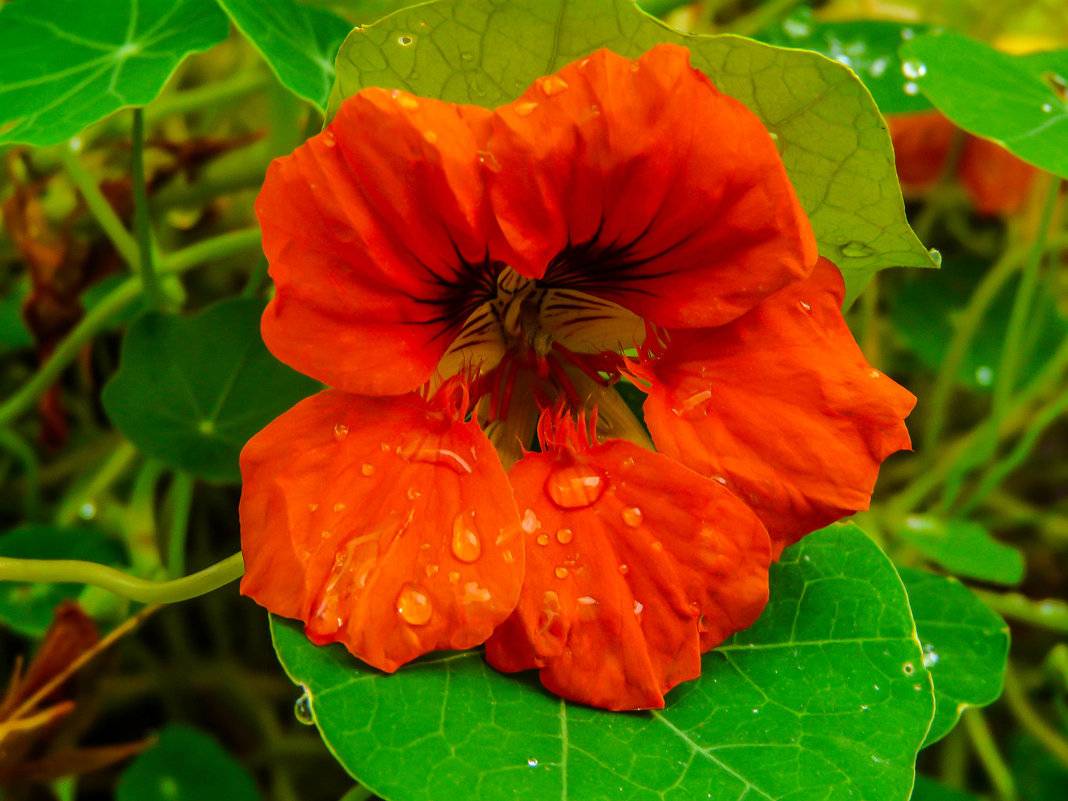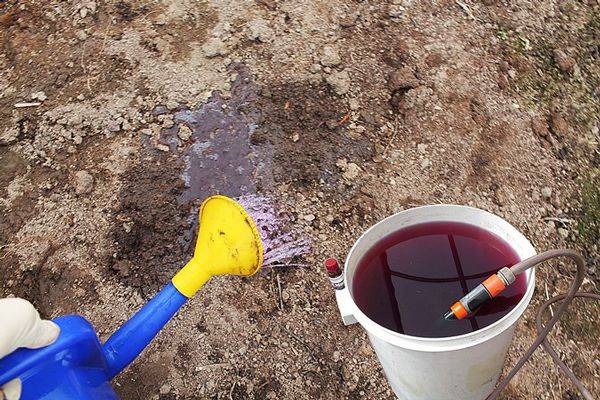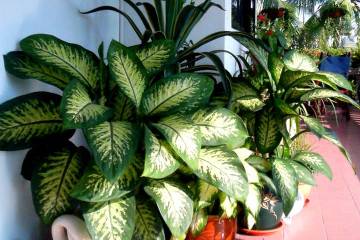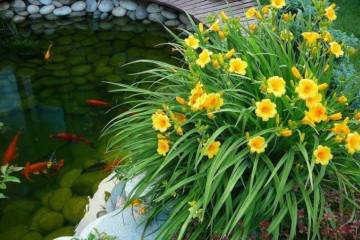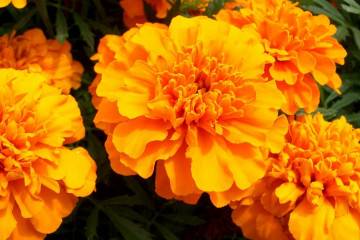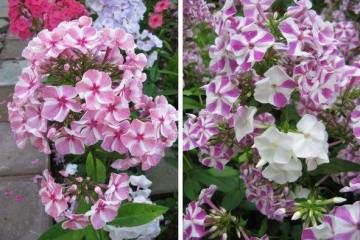Diseases of nasturtium - why leaves turn yellow
Content:
- Diseases of nasturtium and their treatment
- Why do nasturtium leaves turn yellow: what to do
- Why does nasturtium not bloom
- Why does nasturtium have sticky leaves?
- Why nasturtium dries up: how to save a flower
- How does nasturtium chlorosis manifest?
- What is powdery mildew in nasturtium (lat.Erysiphaceae)
- Gray rot (lat.Botrytis cinerea)
- Black rot of nasturtium (Latin Guignardia bidwellii)
- Signs of late blight (Latin Phytophthora infestans)
- Brown spot of nasturtium (Latin Phyllosticta petuniae Sp.)
- Causes of nasturtium disease
- Agrochemistry and plant protection
The beauty of nasturtium began to be used for decorating flower beds relatively recently. The fact is that up to the 16th century. this plant was used exclusively as a spice with an unusual aroma. In the homeland of nasturtium - in Central America - people ate the roots of the plant, but the Europeans first appreciated the taste of leaves, flowers, fruits, and only after that they began to grow bright bushes in their gardens. Today, these original flowers are grown on their plots by gardeners from different countries, and therefore nasturtium diseases deserve special attention.
Diseases of nasturtium and their treatment
A few decades ago, the seeds of nasturtium, the second name of which sounds like capuchin, were used by sailors returning home from American voyages to treat scurvy and colds. The components of this plant are still used today in folk medicine, cooking and cosmetology. However, nasturtiums themselves can be sore. Until recently, a lush flowering bush suddenly wilted and withered, the leaves turned yellow, flowering slowed down or stopped altogether, rot and necrotic spots appeared ... Of course, it is not easy to deal with such problems, but with proper care you can make any disease stop.
Why do nasturtium leaves turn yellow: what to do
Experienced gardeners say: under favorable weather conditions, thermophilic nasturtium is grown as a perennial plant, but they simply cannot survive the frosty winter. That is why, in temperate climates, they are grown as garden annuals, growing in a solid carpet, decorating borders and entwining gazebos.
The appearance of the plant is incredibly attractive - smooth semi-double and double flowers, green waxy leaves. Ampel capuchin species are ideal for growing in hanging pots, as they can be used to decorate verandas and balconies.
The yellowing of the lower leaves is usually associated with a lack of sunlight or natural aging of the plant. Why do the top leaves of nasturtium turn yellow? This may indicate that the weather is too hot or rainy. In the first case, the sun's rays burn the leaves and deprive them of moisture, in the second case, root decay is the reason, which means that the problem can be solved with the help of additional drainage. In addition, yellowing can be a sign of infection of plants with infectious diseases.
Experts say: attention should be paid to the dislocation of yellowness: yellow-green spots on twisted leaves may indicate a viral mosaic carried by various insects.
Why does nasturtium not bloom
There are many reasons why nasturtium does not bloom. It can be:
- low air temperature;
- lack of care;
- non-observance of the rules of agricultural technology;
- insufficient amount of sunlight;
- heavy clay soil.
Short daylight hours lead to the plant entering a dormant period. This means that it is preparing for winter, and therefore it is not worth waiting for flowering. Sudden changes in temperature, such as hot days but cold nights, also negatively affect the ability of plants to form buds. Speaking about why nasturtium grows poorly and does not bloom, one cannot but say about the soil. Clay soils, which do not allow water to pass through, worsen the condition of the root system.
Why does nasturtium have sticky leaves?
Gardeners who grow this flower on their site often notice that the established warm weather leads to the fact that the leaves of the plants become sticky. There is no secret, the whole point is that pests, for example, aphids, multiply in huge quantities at this time. Just one female per season can produce offspring of several thousand larvae. They very quickly turn into adults, feeding on the juices of a wide variety of horticultural crops. In this case, insects secrete a sticky sweetish substance. Pests of nasturtium can be destroyed; for this, the bushes must be treated with insecticides in a timely manner.
Why nasturtium dries up: how to save a flower
Sometimes you can see that the opened flower suddenly begins to dry out right in the midst of the flowering culture. This should be alarming. Poor maintenance, pest attacks, disease, or poor soil conditions may be the cause. If all negative factors are eliminated, but the nasturtium inflorescences continue to dry, the bushes will have to be destroyed.
If capuchin flowers dry up in the fall, there is no cause for concern, as this is due to a cold snap and a decrease in the amount of sunlight. In the fall, the flower enters the dormant stage, it is at this time that you can start reproduction. To do this, you need to select several healthy stems, cut them into cuttings, while each should have 2-3 internodes and two leaves. The lower parts of the cuttings must be treated with a special agent that stimulates root formation, put in water.
After the first root shoots appear, the cuttings can be planted. The best soil option is a mixture of peat and sand. After a while, you can start adding nutrient soil and various fertilizers to the pot. In spring, seedlings can be transplanted to a permanent place in the open field.
How does nasturtium chlorosis manifest?
Deficiency of iron in the soil or the inability of the roots to extract this chemical element in order to send it to the leaves, often leads to the fact that capuchins shed their inflorescences, often the leaves of nasturtium turn yellow. What to do? For treatment, experienced gardeners recommend feeding nasturtium with preparations that include iron chelate, as well as an antichlorosis agent.
What is powdery mildew in nasturtium (lat.Erysiphaceae)
Powdery mildew is a fungal disease that usually appears as white spots with dark brown spots. Spore balls are formed both on the leaves and on the stems, after a while they thicken, changing the color to grayish-brown.The plant withers, growth stops, leaves and stems may turn black.
Gray rot (lat.Botrytis cinerea)
It is quite simple to recognize this disease: the leaves of the nasturtium curl, the color of the stems changes, the tissues soften, the roots rot, the inflorescences fall off. Most often, the pathogen of gray rot is carried by air or through the hands of the gardener after he has come into contact with another infected plant.
The main way to combat gray rot is to completely destroy the pathogen. First, you need to remove all parts of the plant that were affected, and then treat the bushes with the following preparations:
- alirin;
- phytosporin-M;
- gamair.
Black rot of nasturtium (Latin Guignardia bidwellii)
Experts say that the fungus that causes the appearance of black rot is common in all countries with a temperate warm climate. Like other fungi, the pathogen is spread by spores. It is quite simple to understand that plants are affected by black rot: white dots appear on the leaves and stems, which expand over time, acquire a brown and then black tint. Indented spots may form. Treating this disease is no different from treating gray rot.
Signs of late blight (Latin Phytophthora infestans)
The genus of fungi that cause late blight has about five hundred varieties. The defeat begins from the lower part of the plant: brown spots appear on the leaf plates of the first tier, covered with a white bloom. Gradually, the fungus infects more and more new parts of the plant.
Brown spot of nasturtium (Latin Phyllosticta petuniae Sp.)
The second name of this disease is phyllostictosis. The pathogens that cause this disease and late blight compete with each other, and therefore at the same time the plant cannot get sick with both.
To cure the bushes, it is necessary to use biological products aimed at getting rid of fungal diseases. Copper sulfate or Bordeaux liquid is also suitable. To detect brown spot, it is enough to inspect the plants from time to time. If you notice olive specks, you should start processing.
Causes of nasturtium disease
Of course, having discovered that diseases and pests have appeared in nasturtium, knowing how to process the plants, the gardener can calm down. However, it is always important to know what is the cause of the problems. In the future, this will help prevent yellowing of the leaves and wilting of flowers, and will preserve the plants.
Temperature violation
It should be said that the Capuchins are natives of warm regions. Despite the fact that breeders are working on the development of frost-resistant varieties, they are still demanding on heat. With a lack of it, they can weaken and even die.
Violation of watering rules
Excessive watering, for which chlorinated cold water is used, can lead to the fact that the root system will simply rot. The upper parts will no longer receive mineral and organic substances that are necessary for the normal life of the plant.
Lack of iron
Why do the leaves of nasturtium turn yellow, leaves and buds fall off, and the shoots dry up? The reason may be non-compliance with the timing of top dressing, which is why the soil bacteria simply do not have time to process chemicals into forms that can be easily absorbed by bushes.
Diseases associated with excess moisture
Most of all fungal diseases of this culture, due to which the leaves of nasturtium curl, stems wither and flowers fall, is associated with an excessive amount of water in the root zone, high humidity and improper abundant watering, during which the leaves become wet. To prevent the appearance and development of fungi, it is necessary to treat the soil and plants with biofungicides in a timely manner, as well as to disinfect any garden tools and structures.
Agrochemistry and plant protection
Gardeners share their experience: in order to protect plants from insects, insecticides will be needed (they can destroy both adults and eggs), fungicides are used to treat diseases, which can be both chemical and biological.
How to treat with folk remedies
Many plants are able to defend themselves and other crops on the site on their own. For example, some of them can give off pungent substances, thereby establishing a kind of barrier between insects and plants. So, phytoncides include nasturtium, garlic, lemon balm, basil and dill.
To cope with late blight, you can use serum, the acidic environment of which will not allow the fungus to multiply on the surface of the leaf plates. Water, to which a few drops of iodine are added, has antimicrobial properties.
Prevention and protection of nasturtium from pests and diseases
Most diseases can be prevented even at the stage of choosing a place for planting a plant and preparing the soil. So, the soil that has been dug up and disinfected is unlikely to contain pathogens of various diseases and insects. Timely loosening of the soil allows you to normalize gas exchange, and harvesting plant residues will protect the site from the appearance of cabbage butterfly caterpillars.
Nasturtium is a rather unpretentious plant, perfectly propagating by seeds, subject to the rules of agricultural technology and care requirements. From the description of this plant, it is clear that if you fertilize it on time, protect it from pests and diseases, it will decorate the garden and become the real pride of the florist.
